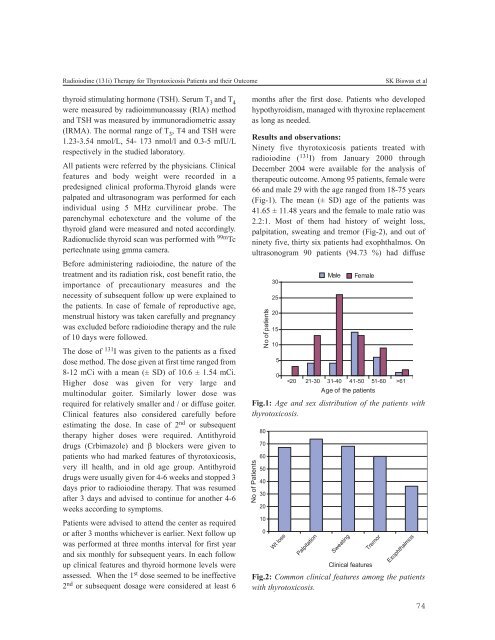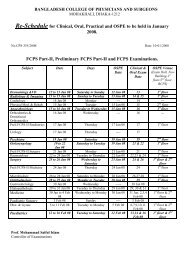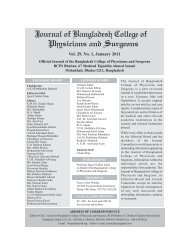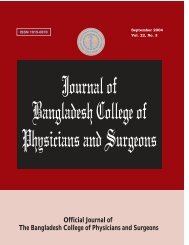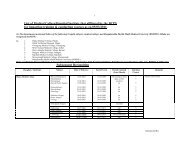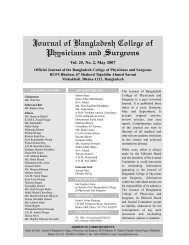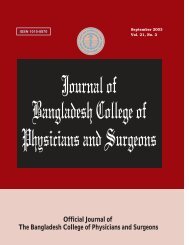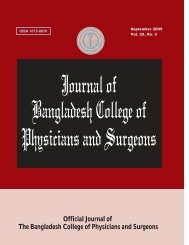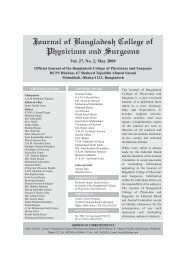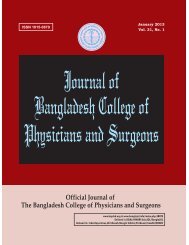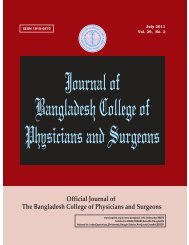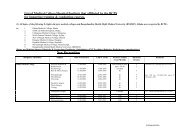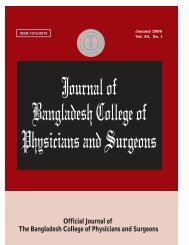May 2008 - bcps
May 2008 - bcps
May 2008 - bcps
Create successful ePaper yourself
Turn your PDF publications into a flip-book with our unique Google optimized e-Paper software.
Radioiodine (131i) Therapy for Thyrotoxicosis Patients and their OutcomeSK Biswas et althyroid stimulating hormone (TSH). Serum T 3and T 4were measured by radioimmunoassay (RIA) methodand TSH was measured by immunoradiometric assay(IRMA). The normal range of T 3, T4 and TSH were1.23-3.54 nmol/L, 54- 173 nmol/l and 0.3-5 mIU/Lrespectively in the studied laboratory.All patients were referred by the physicians. Clinicalfeatures and body weight were recorded in apredesigned clinical proforma.Thyroid glands werepalpated and ultrasonogram was performed for eachindividual using 5 MHz curvilinear probe. Theparenchymal echotexcture and the volume of thethyroid gland were measured and noted accordingly.Radionuclide thyroid scan was performed with 99m Tcpertechnate using gmma camera.Before administering radioiodine, the nature of thetreatment and its radiation risk, cost benefit ratio, theimportance of precautionary measures and thenecessity of subsequent follow up were explained tothe patients. In case of female of reproductive age,menstrual history was taken carefully and pregnancywas excluded before radioiodine therapy and the ruleof 10 days were followed.The dose of 131 I was given to the patients as a fixeddose method. The dose given at first time ranged from8-12 mCi with a mean (± SD) of 10.6 ± 1.54 mCi.Higher dose was given for very large andmultinodular goiter. Similarly lower dose wasrequired for relatively smaller and / or diffuse goiter.Clinical features also considered carefully beforeestimating the dose. In case of 2 nd or subsequenttherapy higher doses were required. Antithyroiddrugs (Crbimazole) and β blockers were given topatients who had marked features of thyrotoxicosis,very ill health, and in old age group. Antithyroiddrugs were usually given for 4-6 weeks and stopped 3days prior to radioiodine therapy. That was resumedafter 3 days and advised to continue for another 4-6weeks according to symptoms.Patients were advised to attend the center as requiredor after 3 months whichever is earlier. Next follow upwas performed at three months interval for first yearand six monthly for subsequent years. In each followup clinical features and thyroid hormone levels wereassessed. When the 1 st dose seemed to be ineffective2 nd or subsequent dosage were considered at least 6months after the first dose. Patients who developedhypothyroidism, managed with thyroxine replacementas long as needed.Results and observations:Ninety five thyrotoxicosis patients treated withradioiodine ( 131 I) from January 2000 throughDecember 2004 were available for the analysis oftherapeutic outcome. Among 95 patients, female were66 and male 29 with the age ranged from 18-75 years(Fig-1). The mean (± SD) age of the patients was41.65 ± 11.48 years and the female to male ratio was2.2:1. Most of them had history of weight loss,palpitation, sweating and tremor (Fig-2), and out ofninety five, thirty six patients had exophthalmos. Onultrasonogram 90 patients (94.73 %) had diffuseFig.1: Age and sex distribution of the patients withthyrotoxicosis.Fig.2: Common clinical features among the patientswith thyrotoxicosis.74


